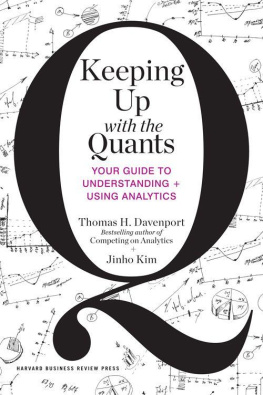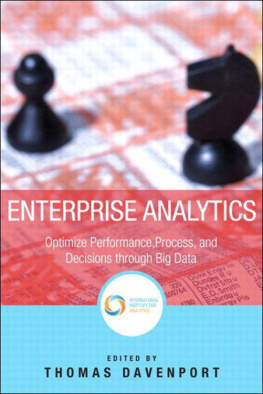Davenport Thomas H. - Competing on Analytics: Updated, with a New Introduction : the New Science of Winning.
Here you can read online Davenport Thomas H. - Competing on Analytics: Updated, with a New Introduction : the New Science of Winning. full text of the book (entire story) in english for free. Download pdf and epub, get meaning, cover and reviews about this ebook. year: 2017, publisher: Harvard Business Review Press, genre: Business. Description of the work, (preface) as well as reviews are available. Best literature library LitArk.com created for fans of good reading and offers a wide selection of genres:
Romance novel
Science fiction
Adventure
Detective
Science
History
Home and family
Prose
Art
Politics
Computer
Non-fiction
Religion
Business
Children
Humor
Choose a favorite category and find really read worthwhile books. Enjoy immersion in the world of imagination, feel the emotions of the characters or learn something new for yourself, make an fascinating discovery.

- Book:Competing on Analytics: Updated, with a New Introduction : the New Science of Winning.
- Author:
- Publisher:Harvard Business Review Press
- Genre:
- Year:2017
- Rating:4 / 5
- Favourites:Add to favourites
- Your mark:
- 80
- 1
- 2
- 3
- 4
- 5
Competing on Analytics: Updated, with a New Introduction : the New Science of Winning.: summary, description and annotation
We offer to read an annotation, description, summary or preface (depends on what the author of the book "Competing on Analytics: Updated, with a New Introduction : the New Science of Winning." wrote himself). If you haven't found the necessary information about the book — write in the comments, we will try to find it.
Davenport Thomas H.: author's other books
Who wrote Competing on Analytics: Updated, with a New Introduction : the New Science of Winning.? Find out the surname, the name of the author of the book and a list of all author's works by series.
Competing on Analytics: Updated, with a New Introduction : the New Science of Winning. — read online for free the complete book (whole text) full work
Below is the text of the book, divided by pages. System saving the place of the last page read, allows you to conveniently read the book "Competing on Analytics: Updated, with a New Introduction : the New Science of Winning." online for free, without having to search again every time where you left off. Put a bookmark, and you can go to the page where you finished reading at any time.
Font size:
Interval:
Bookmark:
HBR Press Quantity Sales Discounts
Harvard Business Review Press titles are available at significant quantity discounts when purchased in bulk for client gifts, sales promotions, and premiums. Special editions, including books with corporate logos, customized covers, and letters from the company or CEO printed in the front matter, as well as excerpts of existing books, can also be created in large quantities for special needs.
For details and discount information for both print and ebook formats, contact .
Copyright 2017 Harvard Business School Publishing Corporation
All rights reserved
No part of this publication may be reproduced, stored in or introduced into a retrieval system, or transmitted, in any form, or by any means (electronic, mechanical, photocopying, recording, or otherwise), without the prior permission of the publisher. Requests for permission should be directed to , or mailed to Permissions, Harvard Business School Publishing, 60 Harvard Way, Boston, Massachusetts 02163.
First eBook Edition: Sep 2017
eISBN: 978-1-63369-373-9
Im convinced that complacency poses one of the most serious threats to any business. Companies so intent on staying the course that they dont hear the footsteps behind them pay a high price for misguided satisfaction. Photographic film companies didnt fully appreciate the threat created by digital photography, and probably even less that it would come from smartphones. Newspapers dependent on classified ads didnt react proactively to online sites like Craigslist. Movie rental companies didnt react fast enough to streaming companies like Netflix.
The story is almost always the same. Winners become also-rans, and eventually case studies, because it was easier to keep doing the things that made them winners in the first place. The path of least resistance was more comfortable than challenging whether what built success would be enough to sustain it.
The founder of UPS, Jim Casey, knew the dangers of complacency and advocated for what he called constructive dissatisfaction. Time and again, Casey restructured and reinvented UPS to counter a host of competitive threats. Over time, one of our biggest competitive advantages came from our early adoption of analytics as a means of continuously assessing and improving every facet of our business.
Analytics enabled us to design one of the first handheld devices, which we put in the hands of every one of our drivers in 1990. To truly harness the power of these devices, we had to kludge together what were then largely regional cellular networks into a proprietary network that covered the United States. That enabled us to gather information on the movement of every package in our system, which in turn helped us build one of the largest data warehouses in the world. The insights we gained via analytics enabled us to achieve new levels of efficiency and to share this learning with customers.
Given a taste of what was possible, our hunger for analytics grew. We created a suite of tools built on predictive models we called Package Flow Technologies. Deployed in 2003, these tools reduced 85 million miles annually. And by opening up our predictive engines to customers and giving them the same information we had, they could interact with our operations directly and personalize their delivery experience.
But for us the analytics jackpot is a prescriptive analytics model we named ORION (short for On-Road Integrated Optimization and Navigation), which tells our drivers which route they should follow to make their deliveries using the least amount of timeand fuel. Its not an overstatement to say that ORION has revolutionized our business. In Competing on Analytics , the book now in your hands, Tom Davenport and Jeanne Harris call ORION the granddaddy of real-time applications and say it may be the largest commercial analytics project ever undertaken.
Before the digital revolution took hold, our managers laid out our drivers routes with pushpins on maps inside our package hubs. Then we transferred that information to our drivers handheld computers. Drivers were taught to follow pretty much the same route every day, delivering our commercial stops first and then their residential stops, because commercial customers were typically more demanding.
But with the e-commerce revolution, residential customers wanted more control over when and where their packages were delivered. Trying to meet the needs of both commercial and residential customers often meant drivers were crossing the same path multiple times, wasting time and fuel.
Our drivers were good at their jobs, and their customers loved them for their reliability and trustworthiness. But we foresaw a day when our drivers could not wring one more second of efficiency out of their routes. When their best would be our best. Then what would we do? (You have to remember these were the days before IBMs Watson was a Jeopardy champion and before we carried the computing power of early mainframes in our pocket.) Whats more, some people in our company thought no computer could improve on what experienced UPS drivers already did so well.
Fortunately, our engineers created a thirty-page algorithm that allows us to determine the optimum route for each of our fifty-five thousand drivers to make their deliveries each day. ORION now shortens each drivers daily route by an average of seven to eight miles, which collectively saves us 100 million miles and 10 million gallons of fuel a year. All told, ORION generates more than $400 million in annual cost savings and avoidance for UPS.
In the process, we have realized the data we collect as a package flows through our network is often as valuable to the customer as the package itself. Based on data extracted from our network, customers are improving their business processes and making more informed decisions, which makes UPS a more valuable partner.
For years, our advertising proclaimed UPS as the company that loved logistics. We still love logistics, but were forever indebted to analytics. And weve since expanded our use of analytics beyond optimizing our physical network, applying it in many other facets of our business.
This revised and expanded version of Tom and Jeannes earlier work brings the analytics story forward, with new applications, insights, and forecasts. The authors show how analytics continues to transform technology from a supporting tool to a strategic advantage.
In Competing on Analytics , the authors not only introduced business leaders to analytics, they also made them analytical competitors, intimately attuned to its business and strategic value. Michael Lewis book Moneyball may have made analytics cool (with a little help from Brad Pitt), but it took Tom Davenport and Jeanne Harris to make it a business imperative.
David Abney, CEO, UPS
April 2017
The world of extracting insights from data was relatively stable for its first thirty years or so. There were certainly technological advances, but the act of creating a bar chart or running a regression analysis didnt change much. An analyst in 1977 submitted the analysis program and the data to a computer on a deck of punched paper cards; the analyst in 2005 submitted it from a keyboard. But the other details were pretty similar.
Since the turn of the millennium, however, the pace of change has accelerated markedly. If we call the way that business intelligence and analytics were practiced before 2007 Analytics 1.0, weve seen the advent of 2.0, 3.0, and 4.0 in the ten years since thenthree massive changes in a decade in how analytics are undertaken within companies.
When we were researching and writing Competing on Analytics in 2005 and 2006, we were largely describing that earliest era and the companies that excelled at it (well recap the idea of Analytics 1.0 in a moment). The companies that competed on analytics then were largely making the best of those older approaches to managing data and turning it into something valuable.
Font size:
Interval:
Bookmark:
Similar books «Competing on Analytics: Updated, with a New Introduction : the New Science of Winning.»
Look at similar books to Competing on Analytics: Updated, with a New Introduction : the New Science of Winning.. We have selected literature similar in name and meaning in the hope of providing readers with more options to find new, interesting, not yet read works.
Discussion, reviews of the book Competing on Analytics: Updated, with a New Introduction : the New Science of Winning. and just readers' own opinions. Leave your comments, write what you think about the work, its meaning or the main characters. Specify what exactly you liked and what you didn't like, and why you think so.

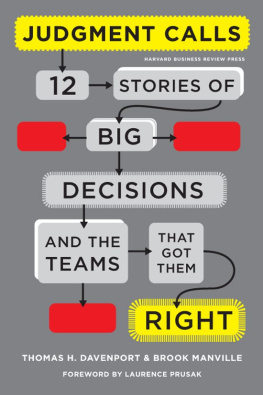
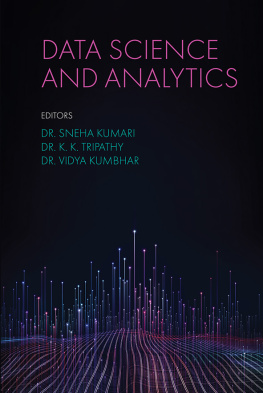

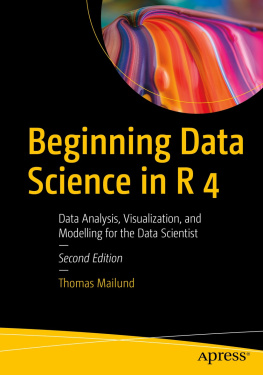
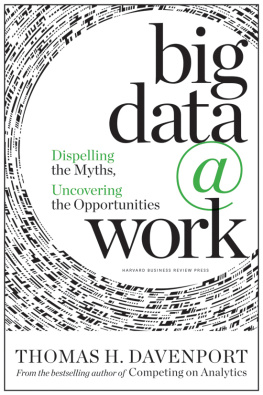
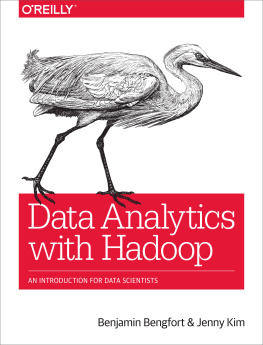

![Thomas W. Miller [Thomas W. Miller] - Web and Network Data Science: Modeling Techniques in Predictive Analytics](/uploads/posts/book/119619/thumbs/thomas-w-miller-thomas-w-miller-web-and.jpg)
![Thomas W. Miller [Thomas W. Miller] - Marketing Data Science: Modeling Techniques in Predictive Analytics with R and Python](/uploads/posts/book/119596/thumbs/thomas-w-miller-thomas-w-miller-marketing.jpg)
